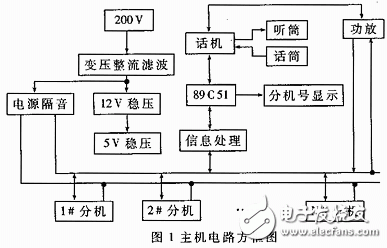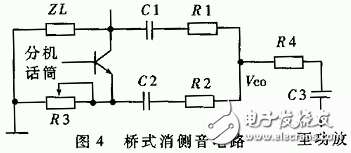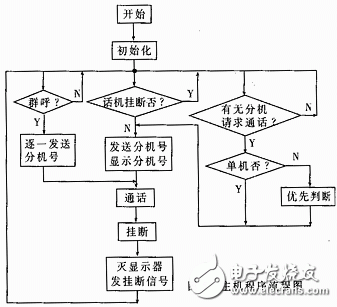Traditional multi-machine communication systems typically require four lines to complete: 1. Power line; 2. Ground line; 3. Transmit signal line; 4. Receive signal line. However, for a system with a long distance between the host and the extension and a large number of extensions, the four-wire system has a large investment and is difficult to install. Based on this problem, this paper combines the transmission call system of analog signal (voice) and digital signal developed for a hospital. It proposes to realize multi-machine communication with a single bus and gives a complete technical solution. When the host needs to talk to a certain machine, the operator picks up the microphone and dials through the commonly used telephone keypad. The display shows the called extension number. At the same time, the digital signal is sent to the bus, and the extension receives the digital signal and confirms the host request. When talking, turn on the analog channel. The voice signal of the host drives the Speaker through the power amplifier and the single bus to the extension's power amplifier. The extension's voice signal is amplified by the amplifier, the side-sound circuit, and the single-bus to the host's amplifier push the speaker or handset. After the call is completed, the host hangs up. At the same time, the host computer sends a stop display signal and the extension hang up signal. The display goes out. After the extension receives the hang up signal, the extension of the analog channel is suspended, thus completing a call. . When the host needs to be connected to each extension at the same time, for example, when the hospital needs to notify all the beds of something, it is unbelievable if the extension is dialed one by one with the keyboard. This design takes into account this aspect of the problem, as long as the operator presses the group call button, the extensions can be turned on within a few seconds to implement the group call. When the extension needs to talk to the host, press the call button (the extension only has one button), and the single-chip microcomputer sends a digital signal to the single-chip microcomputer of the host through a single bus. After receiving the signal, the host single-chip microcomputer displays the extension number to determine whether the phone is hung up. If it is in the hang-up state, the loop judges until the phone hangs. After picking up the microphone, the host immediately sends a signal to the corresponding extension to allow the call. The extension can connect to the analog channel to make a call. When the call is completed and the microphone hangs up, the host sends an hang up signal to the extension, and the extension suspends the ground of the analog channel. In this way, energy is saved and the normal work of the personnel of the downtime is not affected. The priority of communication must be given priority in the call system for the hospital's critical illness number, the vital department of the organization, and so on. In this design, after the host receives a large number of call signals, it first determines the priority, turns on the extension call with the highest priority, and then gradually talks with the lower priority extension. In a single-bus multi-machine communication system, a digital signal, an analog signal, and a power supply share a line. If no measures are taken, the alternating digital signal and analog signal will be absorbed by the filter capacitor of the power supply. In this design, when no power isolation circuit is added, the alternating 5V signal is only 10mV after the transmission line to the extension. After the isolation circuit shown in Figure 2 is used, the signal is transmitted to the extension greater than 250mV, and the attenuation of the signal is significantly improved. The isolation circuit of the diode, transistor, voltage regulator, inductor and resistor in the figure is used for the host, and the extension only needs one inductor and one diode. A single bus must transmit both a voice signal and a voice signal, which is bound to form a loop. In order to solve the problem of hearing your own voice (called the side tone), a side-sounding measure was taken. In general, there are methods for eliminating sidetones: one is a bridge-side eraser circuit; the other is a side-cancellation circuit with phase cancellation, which is more effective. Considering the cost debugging factors of one host and multiple extensions, the main part adopts the phase cancellation cancellation side sound circuit, and the extension uses the bridge side cancellation sound circuit. The phase cancellation cancellation side sound circuit is shown in Figure 3. The circuit consists of three operational amplifiers and corresponding resistors, capacitors and potentiometers. The extension signal from the bus passes through RW1 and F3 to the power amplifier. The microphone signal of the host passes through the power amplifier 1, the bus, the non-inverting input terminals of RW1 to F3, and the other through the inverting input terminals of F1, F2, RW2 to F3. Adjusting the appropriate K, C, RW1, and RW2 values ​​causes the host's microphone signal to approach zero volts at the F3 output, eliminating sidetones. The bridge side noise circuit is shown in Figure 4. The whole circuit is composed of a national transistor (voice transmission amplification) and R and C components. In the figure, ZL is the equivalent impedance of the external line. When the extension sends the signal of the telephone, the output of the single-frequency signal is outputted by the emitter of the triode, and the national road is further added to the emitter of the triode through the external line ZL and the resistor R3 to form a current loop; the other country passes through R1, C1, R2 and C2. A current loop is formed. If the bridge is balanced, ie ZL(R2-j1/ωC2)=R3(R1-j1/ωC1) then Vc0=0 Since the input signal of the rear stage power amplifier is zero, the speaker does not sound and the side sound is eliminated. The analog signal from the host through the bus is amplified by R1, C1 and RC to the voltage amplifier for power amplification.
We are dedicated charging solution Manufacturer since 2005.
Supply various Power Station including Portable Power Stations, Solar Power Generators, Smallest Generator etc.
Manufacturing high quality products for customers according to international standards, such as CE ROHS FCC REACH UL SGS BQB etc.
To constantly offer clients more innovative products and better services is our consistent pursuit.
portable power stations for camping, solar pow er stations, jackery portable power station TOPNOTCH INTERNATIONAL GROUP LIMITED , https://www.mic11.com
The main function of the multi-machine call system realized by this design is: the extension calls the host, and uses the single-chip microcomputer to send digital call information to the host. After the host responds, it displays the extension number of the call, and opens the analog channel of the host and the extension for the host and extension. The intercom; the host calls an extension, the host part outputs the extension number, directly opens the analog channel of the corresponding extension, and performs the intercom between the extension and the host; the group call, mainly sends the digital information of all the extensions one by one, and opens all extensions within a few seconds. The analog channel, the host transmits voice signals to each extension. The core problem of implementing such multi-machine communication with a single bus system is how to distribute power, ground and signal lines, how to transmit signals in both directions, and how to solve mutual interference between them. The author shares the signal (including digital signal and analog signal) with the power supply and the other line is the ground line - single bus system. In the circuit structure and technology, the power isolation circuit is adopted to greatly reduce the influence of the power supply filtering on the signal; the processing of the analog signal is completed by the elimination side sound circuit. The block diagram of the host circuit is shown in Figure 1. 




